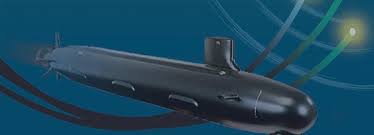
Exelis is a local Salt Lake City company that works with the U.S. Navy developing and manufacturing components used in submarine and surface ship sonar systems. How did a landlocked company form a Navy partnership? It all started in the 1950s.
The company started out as King Laboratory. They manufactured “crystals” needed in the then-current sonar process. Salt Lake was picked as the site for its low humidity. Back then environmental controls were non-existent so the work went to the environment rather than the other way around. In 1956, the company was bought by EDO Corporation who continued to refine the process, switching from crystals to piezoelectric ceramics, and expanded the working partnership with the Navy.
EDO was eventually acquired by ITT which spun off into three publicly traded companies, one of which was ITT Exelis that concentrated on sonar (among a wide range of defense and aerospace capabilities). In 2014 ITT Exelis became Exelis.
The original sonar technology came from data and equipment captured from the Germans in World War II. Using U.S. Navy requirements, the company helps develop and manufacture components or systems installed in submarines or surface ships. And all of it rests on a technology of piezoelectric ceramics discovered in the 1880s. As the technology at the heart of all sonar systems, piezoelectricity is the charge that can accumulate in materials, like ceramics, in response to mechanical stress.

John Holmes, the general manager for Salt Lake’s Exelis facility, explains how that works for sonar. “The piezoelectric ceramic, when in the presence of a sound wave, develops a voltage which can then be processed to determine range and location of the sound source.”
This capability is critical to ensure the safety of our warfighters. The company manufactures transducers used in anti-submarine warfare, underwater communication and depth sounding.
The classic submarine “ping” is produced when the transducers send out a sound wave.Transducers can send and receive sound waves. Exelis also produces hydrophones used in undersea mapping and navigation. The hydrophones can only receive sound waves and are therefore known as a passive system.
The Navy isn’t alone in using the technology. Holmes outlined many of the private and commercial applications from piezoelectric ceramics.
It is used in oil and gas exploration at sea or on the land. By placing a transducer at the tip of a oil rig drill bit that typically travels 20,000 to 30,000 feet deep through intense heat and pressure, it will measure rock density and the readouts inform the operator when rock gives way to an oil reservoir.
It can also be used in physical therapy because as the ceramic vibrates it creates therapeutic heat. Some other uses are medical ultrasounds, ultrasonic welding, ultrasonic cleaning for jewelry, and it is even used to seal that annoying plastic packaging that is so frustrating to open.
Holmes claims that one of the most exciting, recent applications is in the area of brain cancer treatment. “We are working with an Israeli company that has found a way to use our technology to slow the growth of brain tumors,” he says.
Chemists are key to the process of making the ceramics and the best fit for their customer’s unique requirements. They consider frequency range and wave strength to determine minute adjustments of the final product.. The manufacturing end takes the raw materials and follows a strict process to produce the ceramics.
“It is amazing when you look at the technology; it touches you everyday,” Holmes says. And as he describes the role in the first Apollo moon landing, he can’t keep the excitement out of his voice. “The lunar lander, piloted by Neil Armstrong, had our technology installed in each leg of the lunar module. They signaled to Armstrong that he was on solid ground instead of dust. He got the ‘blue light’ that it was safe for him to turn off the rockets.”

Story by Connie Lewis





